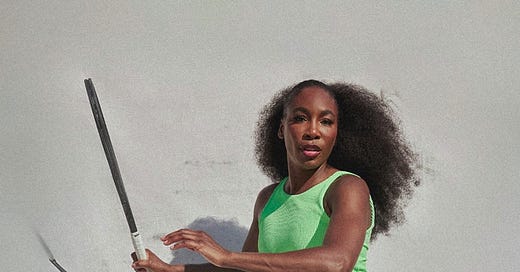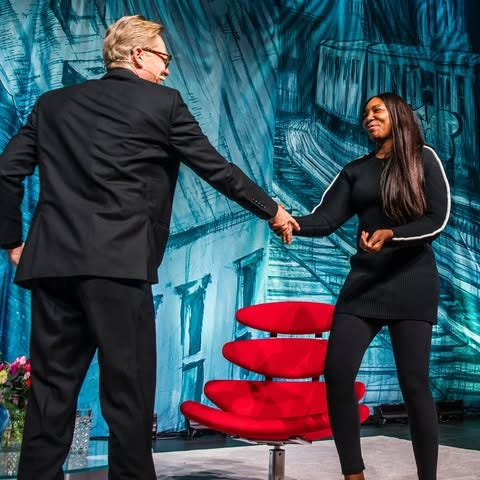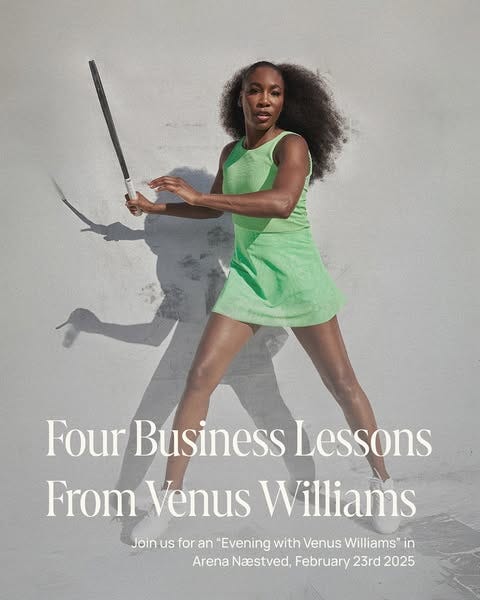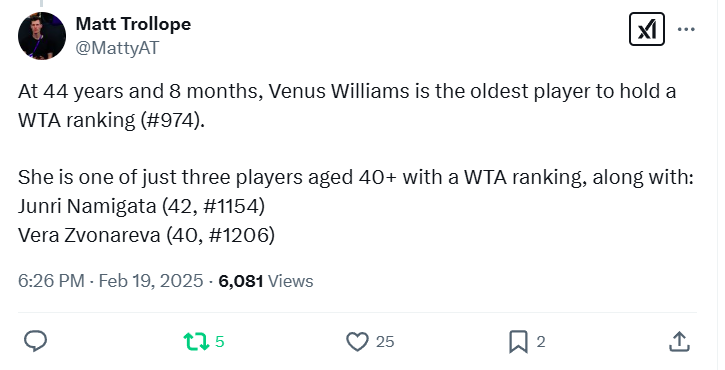Venus, Vanishingly
After an invitation from Indian Wells, forecasting the future of Venus Williams proves complicated.
On my second day at the Mexican Open in Acapulco, my thoughts drifted far from this hot and humid resort city, to a stage in a small Danish town about an hour southwest of Copenhagen.
An Evening Star
Venus Williams was being interviewed today on that stage in the town of Næstved, Denmark, one of many paid public speaking engagements the seven-time major champion fills her calendar with in recent years.
Today’s event was billed as “An Evening with Venus Williams,” in which Venus would be interviewed by Adama Ibrahim, a vice president at Danish pharmaceutical giant Novo Nordisk and a member of of ProWoc (Professional Women of Colour in Denmark).
VIP tickets, according to the event website, were being sold for about US $210, not including fees. VIP attendees could add on about US $70 more for a meet-and-greet dinner with Venus. Cheaper options for the evening ranged around US $138 to get in the door.
Venus and Ibrahim, according to the program, would hold “an engaging conversation about the gender gap, entrepreneurship, investments and – of course – how to STRIVE,” as the title of Venus’s latest motivational book is “Strive”.
All of this is normal fare for a popular and inspiring former champion whose worldwide resonance remains strong. But the event caused waves—and gained notice, thanks to the reporting presence of Chris Kneebone of the Tennis Weekly podcast—when he reported that Venus had refuted a news item from four days earlier: that the BNP Paribas Open in Indian Wells had announced she was one of the players receiving the first batch of main draw wild cards into next month’s tournament.
From Wednesday’s press release:
“The BNP Paribas Open announced its first four wild cards for the 2025 event, awarded to Grand Slam champions Venus Williams and Petra Kvitova as well as rising teenage ATP talents João Fonseca and Learner Tien.
Williams, a Southern California native, has competed on the WTA Tour for more than 30 years since her debut in 1994…The 2025 BNP Paribas Open will mark Williams’ tenth career appearance at Indian Wells, having reached the semifinal three times (1998, 2001, 2018) and competing most recently last year as a wild card.”
But rather than expressing excitement at her announced return to competition—which was set to be Venus’ first tournament since last year’s Miami Open 11 months ago—Venus spoke of the wild card with amused bemusement.
Here’s the audio of the exchange between Venus and Ibrahim, transcribed below:
Adama Ibrahim: …and now with the wild card coming up!
Venus Williams: Well actually, I’m not—that wasn’t true. That wasn’t true!
Adama Ibrahim: Really?
Venus Williams: No, I’m not playing. Yeah, actually I found the announcement super amusing, because, I don’t know, people seemed to be happy? So I was like, maybe I’ll just go with it? I don’t know. I’m not going. I’m going to be overseas. I’m going to watch it on TV. I’m sorry, guys.
Adama Ibrahim: Thanks for letting me know. You heard it here.
Venus Williams: I just had a player text me today, too, like: ‘Can you play doubles?’ (Laughs) I’m not playing! I found out about the wild card when you guys did. Just saying. I love Indian Wells; I would love to be there. And if I could have accepted it, I would have been like, ‘Yes.’ But I already made commitments and all that…
This was quite a twist. About four hours after I inquired to the Indian Wells PR team about this strange discrepancy, they responded with a statement from tournament director Tommy Haas:
“Our team has been informed that Venus is not accepting the wild card this year. We wish Venus all the best and hope to see her back in Indian Wells in the future.”
What Happened Here?
This is a puzzling, and seemingly unprecedented, incident to decipher. (I should add that Venus Williams’ longtime agent, Carlos Fleming, did not return a message seeking clarification.)
Plenty of tournaments will announce and publicize the planned appearances star players who don’t wind up attending—and even of those whose participation never seemed likely to insiders (see: Rafael Nadal’s predictable, nearly annual withdrawals from Halle or Queen’s Club after his deep runs at the French Open). But I can’t remember any incident like this one, in which the player in question denies that they ever had plans to play in an event that had announced their participation. Certainly, at least, not from a prestigious tour event like Indian Wells, which would have no reason to intentionally oversell its roster.
Wild cards aren’t announced in tournament press releases when they are still tentative or speculative. Sometimes the tournament director of a small tournament might float the names of some star player wish list in an interview with local media, but that’s not what happened here.
In order for this announcement to happen, there would have had to have been some interest in playing Indian Wells expressed, at some point, from someone on Venus’s side. For mandatory tournaments like Indian Wells, wild card requests are normally made by filling out and signing a form, either by the player herself or her agent. In rarer circumstances, a tournament could reach out proactively to a player to gauge interest if they think she is planning a comeback but hasn’t entered using a protected ranking (or doesn’t have one available, which would be Venus’s case); that would still probably involve the form being filled out.
Unless either side gives more information, how this impasse happened will remain open for speculation.
After thinking it over—and chatting with several tour veterans who messaged me today about this bizarre scenario unfolding—I do have a theory of the case, speculative though it is: my hypothesis is that Venus, at some point, requested this wild card from Indian Wells, or indicated to someone on her team her interest in playing at Indian Wells and they did it on her behalf. (I would assume that a similar request was also probably made for Miami if Venus was planning a March comeback.) But at some time between that indication of interest and her comments on stage in Denmark, Venus lost the desire to play, whether through a loss of interest, fitness, or confidence.
I think the history of the Williams family at Indian Wells, which I don’t need to rehash in full here, also probably explains why the tournament phrased the message the way it did. The Williams family’s boycott of the tournament was a considerable bruise on Indian Wells for years, a bruise that’s still visible in certain light, and I don’t think they’d want to do anything to possibly darken that mark after a feeling of healing between the two sides in the last 10 years.
So, What’s Next for Venus Williams?
Venus has been working toward some sort of comeback, that I know. I heard during the Australian Open last month that Venus had begun training again, which would indicate a planned return to professional tennis.
One part of Venus’s comments in Denmark that stood out to me was how she characterized the reaction to the announcement of her wild card: “People seemed to be happy?”
The reaction I saw to the news on social media, however—and which Venus also would have likely seen—was distinctly mixed. For all the fans and admirers of Venus who were excited to see her play again, there were also many loud naysayers who were bemoaning the Indian Wells tournament giving a wild card spot to a 44-year-old whom they didn’t expect to be competitive against the elite field there. There were younger players, these groaners said, who would “deserve” a wild card more.
I always balk at this verbiage: for me, the concepts of “wild card” and “deserve” repel one another. Wild cards are, by definition, about giving someone a chance that they probably don’t objectively deserve—and that’s OK! In the current tennis rules, tournaments are permitted a small percentage of their entries to be wild cards in order to make the field more attractive1. And Venus Williams, as you can tell by Danish folks shelling out hundreds of dollars to watch her talk today, remains a pretty great attraction. Indian Wells would have every reason to think including her was a good decision for its event, and for its attendees.
But the detractors were right, in part: Venus Williams should not be expected to be a competitive player on tour right now. Venus is 44, less than four months from turning 45. As Matt Trollope recently noted, she’s by far the oldest player to currently hold any WTA ranking; hers is currently 974th.
That’s already remarkable. But when Venus has played in recent years, she hasn’t won much: Venus has won only 7 of her 34 matches since turning 40.
There have been a few highlights, to be sure: her win over Camila Giorgi in a third-set tiebreak in Birmingham in 2023, shortly after her 43rd birthday, was a thrill for Venus and her fans.
But a few months after that, Venus suffered an awkward drubbing after being put in a night session match on Arthur Ashe Stadium for the first round of the 2023 U.S. Open, losing 6-1, 6-1 to 97th-ranked qualifier Greet Minnen. It was a decidedly uncomfortable match for the supportive crowd to witness unfold.
Venus, normally taking sole blame in defeat, was extremely effusive in her praise of Minnen afterwards. “But I really have to give credit to her: it was just incredible, honestly,” Venus said of Minnen. “I mean, if she can play like that, you imagine that she can be in the top 10 or perhaps No. 1 or maybe win a Grand Slam, something like that, if she can play at this level.” (Minnen, now ranked 96th, has still not broken the Top 50.)
Venus did not play again in that 2023 season. She then lost the only two matches she played last year, when she received wild cards into Indian Wells and Miami.
All of this begets the question: does Venus have an exit strategy from competitive tennis?
It seemed like she might, about six months ago. For last year’s U.S. Open, Venus did not enter the tournament, but was announced as a player in a pre-tournament “Stars of the Open” exhibition featuring herself and three retired players in a mixed doubles match: Andy Roddick, Juan Martin del Potro, and Gabriela Sabatini. By signing up for this event, but not the U.S. Open itself, it felt as though Venus was soft-launching retirement from the tour.
But Venus ultimately pulled out shortly before that exhibition match, however, replaced by Caroline Wozniacki (who has also engendered some recent re-retirement speculation by not entering tournaments this year).
I don’t know what Venus’s endgame is in all this, or if she even has a semblance of one in mind, but I do hope she can figure out some sort of gentle landing from the sport that she has given so much to over the years. She almost certainly doesn’t want the fanfare that Serena’s exit had at the 2022 U.S. Open, but she deserves to have a finish to her career that she’s as comfortable with as possible.
If Venus wants to keep playing on the tour, at the very least, I think she should try downshifting away from the pressure and intensity of tour-level singles and into doubles, a nifty discipline in which she’s won 16 major titles after all. That doubles foray, if need be, could be framed as a way to ease back into singles someday (remember that Serena played doubles in Eastbourne with Ons Jabeur before her own short singles farewell tour in 2022).
Because, really, what Venus was trying to do, coming back cold into tour-level singles at 44, is almost certainly not going to yield satisfying results for her. That’s just going to be too high of a barrier to clear without a pretty long, gradual on-ramp. To put her age in context, Venus was older than five of the six retired WTA players who competed in the Australian Open Legends event last month (only 47-year-old Iva Majoli was a couple years older than her).
If Venus still wants to maintain the guise of being an active tennis player—for the record book, for her own ego, for her speaking fees, whatever it may be—that’s fine. But her return to the court, if there is one, shouldn’t be an abrupt arrival into a singles match, unless perhaps it’s explicitly with the knowledge that it’s going to be a farewell, like Simona Halep’s was recently.
Jon Wertheim memorably once wrote that it would feel more apt if the two tennis-playing Williams Sisters swapped names. Venus, after all was the decidedly more serene one, while Serena had the power of a bright, tempestuous planet with a powerful gravitational pull.
But Venus Williams, right now, reminds me of the planet, too. Venus is close to us, sure, but still ultimately distant and unknowable. Venus has been orbiting as long as we can remember, and there’s no sign of anyone stopping Venus any time soon: Venus is going to keep spinning on and on and on.
The ATP 500 tournament this week in Acapulco couldn’t find any big stars to take late wild cards and chose to just give their two remaining wild cards to the highest-ranked players below the cut—Daniel Altmaier and Buyunchaokete—which happens occasionally.









Nicely done. One thing about the Venus wild cards that rubs the wrong way: There is a presumption that WCs go to players who are relevant, were recently relevant or are widely expected to soon be relevant. Venus doesn’t fit any of those criteria. From the WTA website, she hasn’t won consecutive matches since Cincinnati 2019. That is a long time. I don’t blame her. I blame the tournaments. They need to stop offering her wild cards. Separately, I’ve often wondered about the business sense of some wild cards. Do they really produce meaningful additional ticket sales? That is, how many people who weren’t otherwise going to Indian Wells would buy a ticket because Venus got a wild card? I wondered the same about Halep in Miami. Maybe a small number of Romanians living in Miami. But if we’re talking about additional ticket sales, it doesn’t seem like it could be a lot.
few people remember lacoste as a tennis player. arthur ashe was a great tennis player but an even greater humanitarian. to understand venus williams, you have to follow the money and listen to what she says. she has always said that she would never tell us when she would be retiring from tennis and for years and years since before “all lives matter”-gate where she promptly pivoted to selling eleven pants at cincy tourney (her brand that was bought out by lacoste), venus has been a wellness entrepreneur. so, report on her as a tennis player all you want. she knows who she is and anybody whose been listening and following the $ can easily find out.